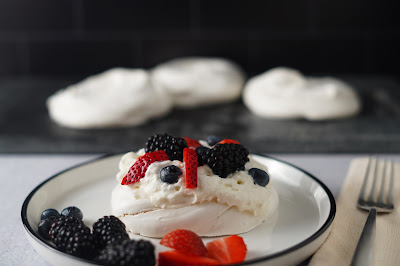Pavlova sounds like a Russian recipe. Assuming that is not exactly wrong; the first time I had it, that's precisely what I thought it was. But Pavlova has a different history. Named after Russian Ballerina Anna Pavlova, this meringue-y dessert originates from either New Zealand or Australia.
Much like my discussions of the origins of lasagna or the battle over the best cheesesteak spot in Philly, I wont take sides in this discussion. However, the story goes that the dessert was described to be "as light as Pavlova", and the name stuck. Of course, if you dig you spoon in a little deeper, you will find that the history is potentially even deeper.
My first experience with Pavlova was in Savannah, Georgia, at a wonderful little coffee shop called Savannah Coffee Roasters. I saw that little bright light of a dessert in the case and it had to be mine. It was love at first bite, and since then - which was seriously 6 years ago - it's been on my wish list. As anyone who scrolls through the blog can see, I've deviated away from frequent dessert baking. This all started when I began working at home, and baking it meant eating it - a dangerous mix! Lately I've focused on savory dishes. Pavlova moved to the front of my mind when my friend mentioned going to Savannah, and I suggested she go to my favorite coffee spot (from which she got a lavender latte and loved!). I reminisced about that sweet, light dessert and decided to make it.
I assumed it would be challenging, or I wouldn't have put it off for so long. I think of French pastries when I look at Pavlova. Light, airy, textured items like croissants are often very time consuming to make. And like when I made eclairs oh so long ago, they can be easy to mess up, too. But Pavlova is not a pastry, and it is not difficult. It's also not exactly as calorie dense as a slice of cake; the bulk of it is whipped egg whites + sugar, and it's topped with whipped cream and fruit.
It all started with egg whites. Just like a meringue, you whip the egg whites for about 5 minutes, until they are light and fluffy. They start out liquid, start to get foamy, then before you know it, you have this light, whipped egg.
I then gradually added in the sugar, beating well between additions. I followed it up by adding vanilla and whipping on high speed again for a few more minutes, until it had very stiff peaks.
It was thicker, but still light and about the consistency of marshmallow fluff.
Prior to all this, I'd heated the oven, so it was ready to go. I spread the egg white mixture in a circular motion, creating a slight bowl shape in the middle.
I placed the pavlova in the preheated oven, then turned the heat off and let them cook for 90 minutes, until the outside was solid. Yes, that's it.
You can see that some of them have little cracks from baking. Lastly, just before I served them I topped them with whipped cream and some fresh berries.
Isn't she lovely?
Though this is kind of like a meringue in that there is a firm exterior, the inside was soft and somewhat moist. That's what really differentiates Pavlova from meringues, which are dry throughout.
As you can see, the prep process is minimal, the baking requires some patience, but the end result is something to be proud of. This is one of those ones you bring over as a guest and get "ooohs" and "ahhhs" for. And I get why - this is a light but satisfying dish. For certain, adding to the baking frequents list.
Pavlova Recipe
Ingredients:
4 egg whites
1 cup extra fine cane sugar (or super fine sugar) - not granulated sugar as this is too coarse
1 teaspoon vanilla extract
1/2 teaspoon cream of tartar
1 teaspoon cornstarch
Whipped cream
Cut fruit, as desired
Heat oven to 350 degrees F. Using a stand mixer, beat the egg whites on high speed until soft peaks form. This will take about 5 minutes. Slowly add sugar, beating between additions. Add vanilla and return mixer to high speed for 2-3 more minutes, until firm peaks form. Stir in the cream of tartar and cornstarch. Spread mixture in a circle as one large piece or 6 smaller pieces onto a parchment or silicon baking sheet-lined cookie sheet, leaving the center concave. Place pan in the preheated oven. Turn oven off. Let pavlova bake for an hour and a half. Let cool, then serve topped with whipped cream and fruit.
adapted from pavlova









No comments:
Post a Comment